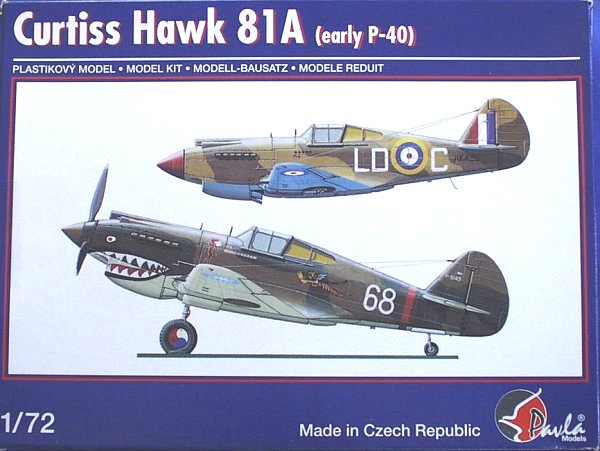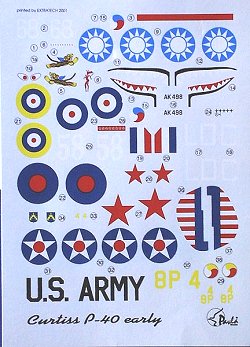
|
KIT: |
Pavla 1/72 Hawk 81 (P-40B/C) |
|
KIT # |
72033 |
|
PRICE: |
$20.00 AUD |
|
DECALS: |
Four aircraft |
|
REVIEWER: |
|
|
NOTES: |
Short run kit with vac and resin bits. |

|
HISTORY |
The Hawk 81/Tomahawk II from a very early stage attracted attention from foreign buyers, and had served with not only the USAAC but with the French, British, Russia and China to name but a few. The Tomahawk IIB carried two 0.3-inch machine guns in each wing in addition to the two nose mounted 0.50-inch. The Tomahawk was fitted with a British radio and served in the Middle East from October 1941 onward, while outclassed by the Bf 109 at heights over 15000 feet, the Tomahawk could more than hold it's own at low altitudes. It could also absorb vast amounts of punishment and still return the pilot safely back to base.
Perhaps the most famous aircraft of the Tomahawk/Hawk series was those supplied to the American Volunteer Group (AVG) A.K.A the famous Flying tigers and in 1941. The US government made available 100 Tomahawk IIB's to the China-based Central Aircraft Manufacturing Company (CAMCO). As a point of interest the famous "sharks teeth" apparently did not originate with the Flying Tigers but were adapted from the markings used by the 112 Squadron RAF in North Africa. (Who adapted them from a Bf-110 unit! Ed)
Many Tomahawk/Hawk 81's were past on to the Russians from about June 1941 onwards, some coming directly from the USA while others were released from RAF reserve squadrons after the threat of a German invasion of Britain was past. The Russian Tomahawks went into action along the Leningrad and Moscow fronts from October 1941 onwards and were the first US built planes to be used by the Russians. (Source for history http://home.att.net/~jbaugher1/p40_6.html )
|
THE KIT |

Pavla's Hawk 81 is molded in the obligatory medium grey on a single sprue that has very thin attachment points, in fact just like the ICM's Su-2 most of the major components had become detached off the sprue and were floating around in the plastic bag. This caused some damage to the fuselage parts as a large chunk had come away with the attachment point. Surface detail is recessed and finely molded with nicely done rivet detail as appropriate but the one piece lower wing suffers from what almost looks like acetate damage around the wheel wells. There is a patch about the size of a 5 cent piece that is rough and "gritty" and looks like the same effect as dropping nail polish remover on plastic and then trying to wipe it off with a paper tissue.
 A little baggie of resin
bits consisting of sidewalls for the cockpit, seat, the complex radiator intake
for the front of the nose, single ejector stubs, single propeller blades (oh
fun!) and finally the gun barrels. The canopy is one of Scotts favorites;
yup, vacuformed, but at least you get two of them so you can screw one up and
still retain your sanity. Rounding off the Pavla Hawk is a small piece of clear
plastic that you cut out the rear windows from.
A little baggie of resin
bits consisting of sidewalls for the cockpit, seat, the complex radiator intake
for the front of the nose, single ejector stubs, single propeller blades (oh
fun!) and finally the gun barrels. The canopy is one of Scotts favorites;
yup, vacuformed, but at least you get two of them so you can screw one up and
still retain your sanity. Rounding off the Pavla Hawk is a small piece of clear
plastic that you cut out the rear windows from.
The instruction book is just that, 18 pages crammed full of decal options and painting details with the 14 construction steps well thought out and easy to follow. Paint colors have Humbrol call outs as the Humbrol is more common in Eastern countries than other brands. FS numbers are given for each color for those of you who want them. On a personal note I welcome "real" color callouts as well as FS numbers as not every country has as yet adopted the widespread use of the FS number system for paint.
Decals are given for no less than four aircraft: A P-40-CU of the 8 pursuit Group Commanders Flight, Langley Field Base, Virginia, Summer 1940; secondly a Tomahawk IIB F/Lt Clive R "Killer" Caldwell of 250 squadron, North Africa 1942 (he gained ten confirmed air victories with this Tomahawk). Third aircraft is a ex British Tomahawk IIB 'white 58" of Lt Alexey S.Khobystov of the 147th Fighter airwing Murmashi airfield, Spring 1942; finally a Curtiss H-81A-2 of Lt Charles N.Older from the American Volunteers 3rd sqaudron "Hells Angels" 1941/1942. This aircraft is also one of the decal options from the Academy kit in the same scale.
|
CONCLUSIONS |
I am really looking forward to building this one as it looks like it will build up into a super Tomahawk/Hawk 81. The level of detail with the addition of the resin is on par with Tamigawa or the Academy kit and only construction will show up any major fit problems, although dry fitting of the major components doesn't show anything too glaring.
Due to the resin parts and vacuformed canopy this isn't one for the complete novice, but would make for a good first foray into the world of mixed media kits or just for a welcome change from that shake-n-bake wunderkit.
|
REFERENCES |
http://home.att.net/~jbaugher1/p40_6.html
Fighting Aircraft of WWII , Bill Gunston ISBN 1-84065-092-3
Kit courtesy of FBN Productions overseas assistance fund.
If you would like your product reviewed fairly and quickly where it will be seen by well over 150,000 visitors a month, please contact me or see other details in the Note to Contributors.